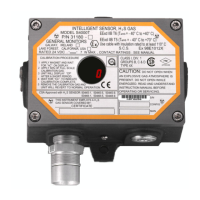Model S4000T
6
3.4 Mounting and Wiring
WARNING - The conduit entries should be sealed per the NEC 500-3d, or Canadian
Electrical Code Handbook (Part 1, Section 18-154). Additional benefit of conduit
seals, is the prevention of water entering the housing through the conduit entry.
WARNING - Unused cable entry holes must be sealed with an approved explosion-
proof plug. Red caps supplied by General Monitors are for dust protection only and
must not be left on unit when installed.
The overall and mounting dimensions for the Model S4000T (Figure 13) should be
used when making installation determinations. A complete list of the mechanical
specifications can be found in Section 9.2.2.
To prevent possible corrosion due to moisture or condensation, it is recommended
that the conduit connected to the Model S4000T housing be sealed, or contain a
drain loop.
Each conduit run from a hazardous location to a non-hazardous location should be
sealed so that gases, vapors, and/or flames can not pass beyond the seal. The
purpose of seals in a Class I hazardous location, is to prevent the passage of gases,
vapors, or flames from one electrical installation to another, through the conduit
system. It is not necessary to seal the Model S4000T housing to maintain its
explosion-proof integrity; however, conduit runs containing wires attached to the
Model S4000T’s relay contacts must be sealed (see Section 3.5).
Information on Class I location seals can be found in the NEC, Article 501-5.
Figure 13 S4000T Outline and Mounting Dimensions
WARNING - Acetic acid will cause damage to metal components, metal hardware,
ceramic IC’s, etc. If damage results from the use of a sealant that outgases acetic
acid (RTV silicone), the warranty will be void.
Once correctly installed, the Model S4000T requires little or no maintenance, other
than periodic calibration checks to ensure system integrity. General Monitors
recommends that a schedule be established and followed.

